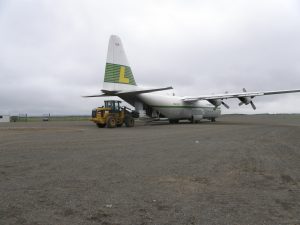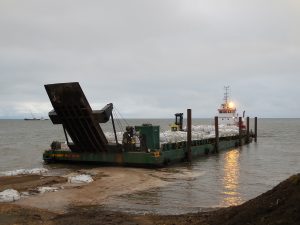Port Heiden
Through our Worldwide Environmental Remediation Services (WERS) contract with USACE-Huntsville, KEMRON was contracted by USACE-Alaska to perform excavation, packaging, transportation and disposal of approximately 37,000 tons of PCB-contaminated soil from the White Alice Radio Relay Station (RRS) in Port Heiden, AK. The work was performed for the benefit of US Air Force, who is responsible for the environmental cleanup of the White Alice RRS.

Since work at the remote area of Alaska is performed only during the warm summer months of May through September, KEMRON and Jacobs, our team subcontractor, coordinated closely with the native village officials and the local construction subcontractor, Aniakchak Contractors LLC. Close coordination with the community is maintained to ensure adequate housing and meals for field workers and availability of the limited labor pool and heavy equipment at Port Heiden during the limited field season. Additionally, KEMRON manages the many logistics involved in cost-effectively transporting equipment and personnel to Port Heiden and removing the waste from Port Heiden given the remote location and short field season.
The project scope includes delineation of known areas of PCB soil contamination, excavation and containerizing these non-TSCA and TSCA regulated soils for transport to Seattle and disposal in Subtitle D and TSCA landfills as required. Confirmation sampling of the excavation areas and analysis at an off-site laboratory is performed to confirm compliance with the 1 ppm PCB cleanup objective.
Planning documents prepared for this project include a Work Plan, Sampling and Analysis Plan (SAP)/Quality Assurance Project Plan (QAPP), Accident Prevention Plan (APP)/Site Safety and Health Plan (SSHP), and a Waste Management Plan (WMP). The preparation of the planning documents, including a Soil Transport Memorandum documenting the regulatory requirements and procedures for the soil barge transport, were expedited and approved by ADEC within six weeks to allow for transport of the first barges of PCB contaminated soil within three months of contract award.
Horizontal and vertical delineation of the PCB contaminated soil is performed using a 15-foot by 15-foot grid system established with RTK GPS. The grids established control for proper sampling, in accordance with 40 CFR 761.61(a)(6) and Subpart O, and controlled removal to minimize over excavation of the soil. Because the cost of removing and disposing of PCB contaminated soils form remote areas, KEMRON diligently manages the depths of excavation to meet the 1 ppm cleanup objective. All sampling and excavation equipment are properly decontaminated between areas and the decontamination process is verified with QC wipe samples submitted for laboratory analysis.
Excavated soils are placed in 10 cubic yard supersacks suspended in a loading frame. Each supersack has a unique identifying number and weights and non-TSCA or TSCA information is recorded for each at the time of generation. Once the supersack is filled approximately 80 percent, the supersacks are sealed and lifted to a flatbed truck for transport to the staging area. The staging area is maintained with a heavy duty HDPE bottom liner and is tarped daily with a HDPE top cover that is weighted to protect from the strong winds and rain common to this part of Alaska.

As there is no road access to Port Heiden, KEMRON schedules barges for the transport of the non-TSCA and TSCA soils to permitted landfill in the lower United States once a sufficient tonnage is ready for shipment. No dock is available at Port Heiden for the barges, so KEMRON constructed a ramp at the shoreline for access to and loading of the barges. KEMRON and its transportation subcontractor, ELM, use a small lightering barge at high tide to navigate the shallow waters present at the landing at Port Heiden. The supersacks of contaminated soil are loaded with the lifting frames to the lightering barge, which then transports them to a larger barge in deeper water. Several trips by the lightering barge are required and all loading work is performed as allowed by tidal and weather constraints. Once both the lightering and large barge have full loads, the PCB contaminated soil is transported to Seattle for offloading to rail for non-TSCA and trucks for TSCA soil. The soils are then transported to the permitted landfills for proper disposal.
Reporting for the project includes daily QC Reports, Weekly Reports describing the field operations, Monthly Project Management Status Report and Annual reports. The Annual Summary Reports provide a summary of the activities performed during the field season, analytical data from the soil delineation and confirmation sampling, and copies of the waste manifests, weight tickets and disposal certifications.